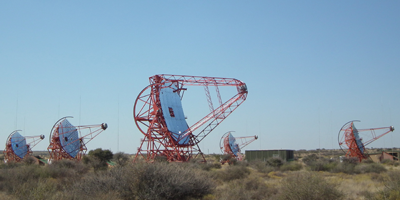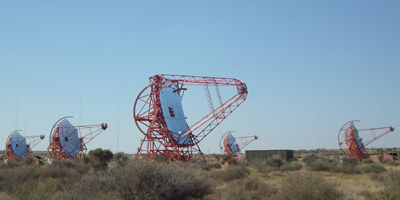Waiting for Dark Matter to Light Up
Clear detection of dark matter would fill some of the more puzzling holes in astrophysics and cosmology. In recent years, researchers have sought after signals originating from annihilation or decay of dark matter particles in space using high-energy messenger particles like gamma rays, electrons, and neutrinos. In a paper in Physical Review Letters, the H.E.S.S. Collaboration reports on their analysis of very-high-energy gamma-ray events, which they detected with an array of ground-based gamma-ray telescopes in Namibia, Africa. As a result, the team has placed upper bounds on gamma-ray flux levels in a largely unexplored energy band between 500 giga-electron-volts and 25 tera-electron-volts, which limits the annihilation cross section to values complementing recent lower energy measurements.
The researchers looked at data taken at times when the H.E.S.S. instrument was pointed (among others) at the central region of the Milky Way, a place expected to have large concentrations of dark matter. In particular, they looked for evidence of a gamma-ray emission line feature that might indicate self-annihilation, however, they observed no signal amid the unavoidable background from high-energy cosmic rays. Nonetheless, the H.E.S.S. team can now set upper limits on the gamma-ray flux from self-annihilation at high energies, and compare these with limits derived at lower energies by the Fermi-LAT satellite. In a sense, H.E.S.S. takes up at the highest energies inaccessible to Fermi-LAT. The search for an actual detection of dark matter continues both on the ground and in orbit. – David Voss





